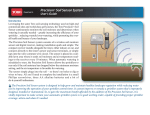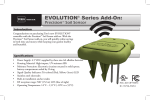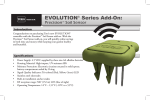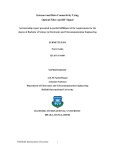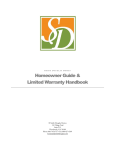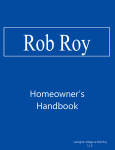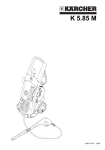Download Toro XTRA Smart Precision Soil Monitoring System (53812) User's Manual
Transcript
Precision Soil Sensor System TM Count on it. User’s Guide Introduction Leveraging the same Toro soil-sensing technology used on high-end commercial sites and world-class golf courses, the Toro Precision™ Soil Sensor continuously monitors the soil moisture and determines when watering is actually needed – greatly increasing the efficiency of your sprinkler system, reducing wasteful over-watering, while promoting the overall health and beauty of your landscape. The Precision system consists of a wireless soil moisture sensor and digital receiver, making installation quick and simple. The compact receiver installs alongside the timer, either indoors or out, and connects directly to the timer’s power and sensor terminals, or simply taps into the valve common wire circuit. The sensor is placed in a suitable lawn area where it sends soil moisture and air temperature readings to the receiver every 10 minutes. When automatic watering is scheduled to start, the Precision system allows the sprinklers to run only if the soil moisture has dropped below the minimum moisture setting, and the air temperature is favorable for watering. The Precision sensor simply plugs into the soil – so there’s no holes to dig or wires to bury. All you’ll need to complete the installation is a small Phillips screwdriver, three AA alkaline batteries and a bit of do-it-yourself enthusiasm. The Precision Soil Sensor system is designed to help grow and maintain healthy landscape vegetation while reducing water use by improving the operation of your sprinkler control timer. It cannot improve or remedy a sprinkler system that’s improperly designed, installed or maintained. So, to gain the maximum benefit afforded by the addition of the Precision system, it is vitally important to make certain your automatic sprinkler system is in good working order; capable of providing proper sprinkler coverage–where and when it’s needed. Table of Contents Introduction . . . . . . . . . . . . . . . . . . . . . . . . . . . . . . . . . . . . . . . . . . . . . . .1 System Component Overview . . . . . . . . . . . . . . . . . . . . . . . . . . . . . 3 System Operating Modes . . . . . . . . . . . . . . . . . . . . . . . . . . . . . . . . . 4 • Normal Operating Modes . . . . . . . . . . . . . . . . . . . . . . . . . . . . . . . 4 •Watering Permitted . . . . . . . . . . . . . . . . . . . . . . . . . . . . . . . . . . . . 4 •Watering Restricted . . . . . . . . . . . . . . . . . . . . . . . . . . . . . . . . . . . . 4 • Smart Bypass Mode . . . . . . . . . . . . . . . . . . . . . . . . . . . . . . . . . . . . . 4 • Freeze Shut-off Mode . . . . . . . . . . . . . . . . . . . . . . . . . . . . . . . . . . . 4 System Status Indicators . . . . . . . . . . . . . . . . . . . . . . . . . . . . . . . . . . 5 • Warning Mode Indicator . . . . . . . . . . . . . . . . . . . . . . . . . . . . . . . . .5 •Restoring Operation . . . . . . . . . . . . . . . . . . . . . . . . . . . . . . . . . . . 5 • Battery and Signal Strength Indicators . . . . . . . . . . . . . . . . . . 5 System Calibration and Learn Modes . . . . . . . . . . . . . . . . . . . . . . 7 • System Calibration Mode . . . . . . . . . . . . . . . . . . . . . . . . . . . . . . . . 7 • Sensor Learn Mode . . . . . . . . . . . . . . . . . . . . . . . . . . . . . . . . . . . . . . 7 Installation and Setup Procedures . . . . . . . . . . . . . . . . . . . . . . . . . 8 • Install Receiver . . . . . . . . . . . . . . . . . . . . . . . . . . . . . . . . . . . . . . . . . . 8 • Connect Receiver to Timer . . . . . . . . . . . . . . . . . . . . . . . . . . . . . . 8 • Select Sensor Installation Site . . . . . . . . . . . . . . . . . . . . . . . . . . . 8 • Install Sensor Batteries . . . . . . . . . . . . . . . . . . . . . . . . . . . . . . . . . . 8 • Install Sensor . . . . . . . . . . . . . . . . . . . . . . . . . . . . . . . . . . . . . . . . . . . . 8 • Adjust the Automatic Watering Schedule . . . . . . . . . . . . . . . 9 Troubleshooting . . . . . . . . . . . . . . . . . . . . . . . . . . . . . . . . . . . . . . . . . 10 Specifications . . . . . . . . . . . . . . . . . . . . . . . . . . . . . . . . . . . . . . . . . . . . 11 Soil Moisture Adjustment . . . . . . . . . . . . . . . . . . . . . . . . . . . . . . . . . 5 • Fine-tuning the Soil Moisture Level . . . . . . . . . . . . . . . . . . . . . .5 Toro Commitment to Quality . . . . . . . . . . . . . . . . . . . . . . . . . . . . . 11 System Operations Menu . . . . . . . . . . . . . . . . . . . . . . . . . . . . . . . . . 6 • Smart Bypass Timer . . . . . . . . . . . . . . . . . . . . . . . . . . . . . . . . . . . . . 6 • Freeze Shut-off Temperature . . . . . . . . . . . . . . . . . . . . . . . . . . . 6 • Watering Completion Time . . . . . . . . . . . . . . . . . . . . . . . . . . . . 6 • Signal Strength . . . . . . . . . . . . . . . . . . . . . . . . . . . . . . . . . . . . . . . . 6 • Battery Voltage . . . . . . . . . . . . . . . . . . . . . . . . . . . . . . . . . . . . . . . . 6 • Sensor ID Code . . . . . . . . . . . . . . . . . . . . . . . . . . . . . . . . . . . . . . . . 6 • Air Temperature . . . . . . . . . . . . . . . . . . . . . . . . . . . . . . . . . . . . . . . 6 • Temperature Format . . . . . . . . . . . . . . . . . . . . . . . . . . . . . . . . . . 6 • Calibration Mode . . . . . . . . . . . . . . . . . . . . . . . . . . . . . . . . . . . . . . 6 FCC Part 15 Rules . . . . . . . . . . . . . . . . . . . . . . . . . . . . . . . . . . . . . . . . 12 2 Warranty . . . . . . . . . . . . . . . . . . . . . . . . . . . . . . . . . . . . . . . . . . . . . . . . . 11 System Operations Menu - Quick Reference . . . . . . . . . . . . . . 12 System Component Overview Receiver 1 - Antenna 2 - Bypass Sensor Button 3 - Bypass Sensor LED Indicator A B C D E 10 4 - Setup Menu Access Button 5 - Cover F L 1 6 - Connection Wire Cable 7 - Setup Menu Adjustment Buttons G K 8 - Watering Status LED Indicators 9 - LCD Display Symbols A- Soil Moisture Control Indicator B - Watering Suspended C - Watering Completion Time D- Smart Bypass Mode Active E - Warning Mode (communication error) F - System Setup Mode G- Freeze Setting Indicator H- Temperature Display Format Indicators I - Alpha-numeric Display Characters J - Battery Status Indicator K - Signal Status Indicator L - Bar Graph Status Indicator Sensor 10 - Sensor Signal LED Indicator J I H 9 2 3 8 13 7 4 6 5 AA AA 12 11 11 - Soil Moisture Probes 12 - Size AA Alkaline Batteries - (not provided) AA 13 - Battery Compartment Cover w/Screws 3 System Operating Modes Normal Operating Modes *Note: A value shown with an asterisk (*) indicates that it is the factory default setting within an adjustable range. Refer to System Operations Menu beginning on page 6 for detailed information regarding system settings and adjustment options. Watering Permitted Smart Bypass Mode When the Precision system is in the Watering Permitted mode, the current soil moisture % value is displayed, and the Green LED is on. In this example, the current soil moisture level is 42%, which is below the *50% soil moisture maintenance level, and watering is allowed. The Smart Bypass feature enables the sprinkler system to operate while the Precision system is in the Watering Restricted mode. Note: If installation of the Precision Soil Sensor system has not been completed or the system is not yet operational, refer to System Installation and Setup procedures beginning on page 8. Watering Restricted When the soil moisture is above the *50% soil moisture maintenance level,, the Precision system switches to the Watering Restricted mode. A delay period of *4 hours begins counting down before watering is actually shut off. The delay period allows any remaining sprinkler zones in the watering cycle to operate. The display will show the current soil moisture % value alternating with the amount of time remaining in the watering cycle completion period. In this example, the moisture level is 96%, and the Green LED is on since watering will be allowed to continue for 4 hours. The Watering Restricted mode will begin immediately following the watering cycle completion period. While in the Watering Restricted mode, the current soil moisture % value with the No Watering symbol will be displayed, and the Red LED will remain on. Note: Ideally, one watering cycle should replenish the moisture level to 100%. Watering program changes may be required to achieve this condition. Refer to your control timer user’s guide for information regarding programming options. 4 Pressing the Bypass button toggles the Smart Bypass feature on and off. When switched on, the Bypass mode will be automatically canceled in *24 hours, or it can be manually canceled at any time. While the Precision system is in the Smart Bypass mode, the Green LED will be on and the Yellow LED will blink continuously. The display will show the current soil moisture % value alternately with the amount of time remaining until the Watering Restricted mode resumes. In this example the moisture level is 85% and the Green LED is on. There are 24 hours remaining in the Smart Bypass mode. Freeze Shut-off Mode If the sensor detects that air temperature has dropped to near freezing, the Precision system automatically switches to the Freeze Shut-off mode to restrict watering. When the temperature rises, the Freeze Shut-off mode is canceled. Normal Operation mode will resume after the delay period set by the Smart Bypass Timer. In this example, air temperature is detected at the minimum setting of *39°F and watering has been canceled. The Freeze temperature and No Watering symbols are displayed, and the Red LED will blink continuously. System Status Indications Soil Moisture Adjustment Warning Mode Indication If the sensor does not communicate with receiver within a 24-hour period, the Precision system switches to the Warning mode, indicated by all three LEDs blinking continuously. Watering will be permitted until the loss of communication has been corrected. Restoring Operation Loss of communication can be caused by a damaged sensor, relocating the sensor to different area of the yard, or a temporary obstruction, such as a car or truck parked in the signal path. However, the most likely cause is the sensor batteries have become too weak to provide adequate signal strength. If the sensor appearance and location is unchanged, and the signal path is unobstructed, replace the sensor batteries with three new AA alkaline batteries. Press the Bypass button to cancel the Warning mode. If communication is reestablished, the Precision system will automatically resume normal operating mode within a short time. Note: If the above measures do not restore normal operation, contact Toro Customer Service for assistance at 1-877-345-8676. Battery and Signal Strength Indications The receiver display provides current battery and signal strength status during all normal operating modes. The number of stacked bars that appear with the corresponding antenna and battery display symbols, indicate the current conditions as shown in the chart below. Signal Battery 6 Bars = Excellent 6 Bars = Excellent 4 Bars = Acceptable 4 Bars = Acceptable 2 Bars = Weak - Check Sensor 2 Bars = Weak - Replace Batteries Landscape plants are the heartiest when their roots become established several inches down where water is stored for the longest period of time. Watering often, for short periods of time, promotes root growth near the top of the soil, where the moisture evaporates quickly. The key to maintaining healthy plants with minimum water waste is to water thoroughly–only when it’s needed. The Precision system is preset to restrict watering until the soil moisture level at drops to 50% of capacity, or 1/2 of the total moisture that can be retained in the soil. If you were to draw a comparison to a car’s fuel tank, 50% of the soil Waste 100% Capacity moisture capacity would be similar to using 1/2 of the fuel Optimum in the tank before stopping to refill. A 50% setting restricts 50% the sprinklers from refilling the Stress soil to capacity until 1/2 of the moisture has been lost; causPermanent Wilt ing the roots to go deeper for 0% water. With the capability to adjust the setting incrementally from 0% to 100%, the Precision system can be fine-tuned for virtually any soil condition. Fine-tuning the Moisture Level Changes to the 50% setting should be made initially in 5% increments in order to see results within a few days. The objective is to find the moisture setting that results in a mild stress condition in the lawn, indicated by slight wilting and dryness. At that point, adjust the setting 5% in the opposite direction. This should result in moisture maintenance level that’s very close to optimum. • Press and release the Plus button to display the current setting (50 % by default). • Press the Plus button to increase, or the Minus button to decrease the setting. • Press Menu button to return to the Normal Operating mode. 5 System Operations Menu The system operations menu lists a variety of operational settings and system status indicators. For most residential landscape applications, the default settings will provide good results. Each setting has a range of adjustment enabling its function to be tailored as preferred. • Press and release the Men button to step through the menu sequence shown in the table below. Note: If you step past a specific menu item, continue pressing the Menu button to repeat the menu sequence. Precision System Menu Item Default Setting Range System Calibration Mode Automatic Manual Reset Watering Completion Time 4 Hours 0–24 Hours Smart Bypass Timer 24 Hours 1–199 Hours Freeze Shut-off Mode Temp 39°F 35–45°F (2–7°C) Signal Strength Indicator Review Only 0.0–10.0+ Battery Voltage Indicator Review Only 0.0–4.5+ Sensor Identification Code Review Only 00 00 00–99 99 99 Temperature Format Indicator °F Sensor Temperature Review Only Watering Completion Time (0–24 Hours) Determines the amount of time allowed for a watering cycle to be completed before the Watering Restricted mode takes effect. Smart Bypass Timer (1–199 Hours) Determines the amount of time the system remains in Smart Bypass mode (and after Freeze Shut-off mode) before returning to the Normal Operating mode. Freeze Shut-off Mode Temp (35–45°F or 2–7°C) Determines the temperature that initiates the Freeze Shut-off mode to suspend watering operation. Signal Strength Indicates signal strength in a digital format. °F or °C 14° F –140° F+ • Where applicable, press the Plus or Minus buttons to adjust the setting value. • To exit the System Operations Menu, either press the Menu button to display the Operating Mode screen, or allow the receiver to idle for 10 seconds and exit automatically. System Calibration Mode Enables the sensor system to be manually calibrated for current maximumsoil moisture content. Battery Voltage Indicates total voltage output of the sensor batteries. Sensor ID Code The Sensor Identification Code is displayed in three number pairs, accessed by repeatedly pressing the Plus or Minus button. Temperature Format Enables temperature format to be displayed in degrees Fahrenheit or Centigrade. Sensor Temperature Indicates the sensor temperature. 6 Sensor System Calibration and Learn Modes System Calibration Mode Sensor Learn Mode The sensor system will be automatically calibrated within 24–48 hours after the initial installation. Calibration is required to establish the maximum amount of usable moisture in the soil. The sensor system will then recognize this soil moisture level as the maximum capacity. From this fixed reference point, the sensor system can gage when the soil moisture has dropped enough to allow watering. To manually calibrate the Precision system at any time, for example, if the sensor has been moved to a different location in the landscape, or has been replaced since the initial installation, use the following procedure: The Precision system receiver has been paired (matched) at the factory to a unique sensor identification code, to prevent communication with other sensors that may be installed within reception range. If either the receiver or sensor is replaced, the frequency pairing procedure is required to enable wireless communication. The receiver Learn mode is provided to accomplish the pairing procedure. • Approximately 2 to 4 hours prior to performing calibration, run an automatic or manual watering operation to thoroughly irrigate the sensor zone. Note: The objective is to apply as much water as possible to the sensor zone – up to the point of runoff, then allow the soil drain down 2 to 4 hours to establish the maximum moistureretention capacity. • Press the Menu button to display CA (system calibration mode). • Press the Minus button to display 00. To pair the receiver to the sensor, use the following procedure: • Press and hold the Bypass button (without releasing) until the receiver switches to the Learn mode and the display shows LE. The Green LED will turn on, and the Red and Yellow LEDs will begin blinking. • If the sensor is operational (batteries installed), paring will occur automatically the next time a signal is sent from the sensor (within 10 minutes). The receiver will automatically return to the Normal Operating mode when communication is established. • If the sensor batteries have not been installed, automatic pairing will occur upon battery installation. Press the Bypass button to return to the Normal Operating mode. • Press and hold the Plus button (several seconds) until the Green LED indicator and hourglass symbol begins flashing. The Red LED will be on. • The new calibrated moisture % value will be displayed automatically within 10 minutes. 7 Installation and Setup Procedures Install Receiver • Position the receiver next to the timer (on the side opposite the timer’s hinged cover). • The receiver can be installed indoors using the mounting tape provided. For outdoor installation, attach the receiver using the two stainless steel screws provided. • When installed outdoors, the receiver cover should remain closed when access is not required. 1. Drive the top mounting screw into the wall, leaving about 1/8” from flush. 2. Place the receiver on the screw using the Mounting Tape keyhole slot. (Indoor Option) 3. Install and tighten the lower mounting screw. 4. Route the connection cable through the bottom of the timer, into the wire connection area. Connect Receiver to Timer Note: If the timer is equipped with sensor terminals, continue at Step 1 below. If the timer is not equipped with sensor terminals, continue at Step 1a. Refer to your timer’s user guide for specific information regarding sensor installation and Sensor control switch operation. Caution: Disconnected power to the timer before to connecting the receiver wires. Red Red White 1.Locate the sensor connec- Timer Equipped with Sensor Terminals tion terminals. If the timer Remove Jumper Wire has (or requires) a jumper PUMP 1 2 3 4 MV COM SENSOR 24 VAC wire on the sensor terminals, connect the receiver for Normally Closed (NC) operation. If a jumper wire Red is not required, connect Red To Sprinkler Valves or the receiver for Normally White Brown (NC) Open (NO) operation. Yellow (NO) 8 2.For Normally Closed operation: Remove the jumper wire, and connect the Brown and White wires to the sensor terminals (in either position). The Yellow wire is not used. For Normally Open operation: Connect the Yellow and White wires to the sensor terminals (in either position). The Brown wire is not used. 3.Continue at Step 4 below. Timer without Sensor Terminals 1a.Remove the wire(s) connected to the field Common terminal (labeled COM or C). 2a.Using a twist-on wire connector, attach the Brown wire to the wire(s) removed from the Common terminal. The Yellow wire is not used. 3a.Attach the White wire to the Common (COM) terminal. 4.Attach the Red wires to the timer’s 24 VAC power terminals. Caution: The receiver requires a source of 24 VAC continuous power for operation. Severe damage will result if wired directly to 110/120 VAC. 5.Apply power to the timer. Note: When the receiver is initially powered up, the green LED will light, and the display will show two bars with alternating Signal and Battery symbols. Adjust Watering Program Review the timer’s automatic watering program and adjust as necessary to provide the following schedule: • Set watering to run every day of the week – with the exception of restricted watering days. • Set the run time duration for each zone that will provide thorough watering – without causing pooling or runoff. • Ensure the automatic watering cycle will start within 16 hours following initial Precision system installation. Install Sensor Batteries Choosing the right location for the sensor is vitally important for the overall effectiveness of the Precision Soil Sensor system. The illustration below represents a typical residential landscape. The blue sections indicate the areas that will receive the most direct sunlight throughout the day may be considered for sensor placement. • Remove four stainless Phillips screws securing the sensor battery compartment cover. Place cover aside. Note: The sensor requires three size AA alkaline batteries for operation. Batteries are not included. • Install the batteries as shown. • Install the battery compartment cover. AA AA AA Select the Sensor Installation Site Note: When the sensor batteries are initially installed, the LED signal indicator is Red. When the receiver links with the sensor, the LED changes to Green. The LED will remain on for 30 minutes to facilitate sensor installation. Install Sensor N • Move the sensor to the proposed installation site. Signal strength is indicated by the LED color as follows: Green = Excellent Yellow = Acceptable Red = Not Acceptable - Relocate Sensor • With a suitable installation site selected, thoroughly irrigate the sensor location and surrounding landscape area by running a manual watering cycle. LED Signal Indicator Fescue Turf Tall Fesque • Trim the grass close to ground level where the sensor will be placed. From among the prospective lawn areas, select an installation site with the following characteristics: • Is representative of the overall soil type and condition. • Is the highest elevation • Is not over a septic tank or drain field • Is well within receiver communication range (500’ line-of-sight) • Is at least 4 feet away from a driveway, roof overhang or downspout • Is not in a footpath or recreational area • Is not exposed to overspray from nearby watering zones. Caution: For close-cut turf varieties, such as Hybrid Bermuda, the top of the sensor must be installed at grade level to prevent damage by mowing equipment. • Applying even, downward pressure on top of the sensor, insert the sensor probes and retention spikes completely into the soil. • At the receiver, press the Bypass to place the Precision system in the Normal Operating mode. Hybrid Bermuda Turf 9 Troubleshooting Solving Reception Problems The Precision Soil Sensor system operates under Part 15 of the FCC rules. This means that it has to comply with certain standards and is only allowed to transmit up to a certain power level. In rating transmitters of any form, typically a Line-of-Sight (LOS) value is used to show the relative effectiveness of a transmitter and allow a transmitter and receiver to be compared to one another using a fair (apples to apples) method. The Precision system has an effective operating range up to 500 feet LOS - meaning in an open field, with no obstructions, the system will have a successfully communication range of up to 500 feet. However, in almost all installations, there are obstacles between the sensor and receiver such as walls, floors, etc. These obstacles will affect the signal reception and typically reduce the radiated signal strength sent to the receiver. Different objects affect the transmitted signal differently depending on the construction material, geometry, and size. Typically, most residential construction materials do not reduce the effective transmitted signal enough to pose problems under normal installation conditions. However there are some indoor installations with very thick walls, or where radio frequency interference is high due to a nearby pump motor or large electrical appliance. To help resolve wireless communication problems: • Install the sensor as close to the receiver location as possible to reduce the potential for interference and signal reduction. If the signal strength is not good in one location, try another appropriate location nearby - just moving the sensor a few feet can greatly improve signal strength. • Interior locations where cell phones or cordless phones have trouble with reception may indicate areas with poor RF signal transmission. The receiver can be installed outdoors and connected to the timer with extended wire leads. 10 Specifications Toro Commitment to Quality - Warranty Receiver Toro Commitment to Quality • Receiver Mounting Options: Indoor or Outdoor (stainless steel screws and double sided tape provided). • Operating Temperature: 14° F –140° F • Receiver Connection Cable: 36”, 24 AWG, 5-conductor, color-coded cable • Receiver Power Input: 22–28 VAC/VDC, 100mA, from existing timer with Class 2, UL-approved transformer. • Output Relay Contacts: Normally Open (NO) and Normally Closed (NC), 3A @ 24 VAC • Receiver Material: High-impact ABS • Operating Frequency: 915Mhz, DSSS (Direct Sequence Spread Spectrum) • Agencies Approvals: UL and FCC. Toro is committed to developing and producing the highest quality, best performing, most dependable products on the market. Because your satisfaction is our first priority, we have provided the Toro Helpline to assist you with any questions or problems that may arise. If for some reason you are not satisfied with your purchase or have questions, please contact us toll free at 1-800-367-8676. Sensor • Power Supply: 4.5 VDC supplied by three size-AA alkaline batteries. • Housing Material: High-impact ABS • Moisture Protection: Electronic circuitry encased in solid epoxy. Battery compartment sealed by precision O-ring. • Signal Quality Indicator: Tri-colored (Red, Yellow, Green) LED • Stainless steel electrodes • Built-in installation anchor stakes Warranty The Toro Company and its affiliate, Toro Warranty Company, pursuant to an agreement between them, jointly warrants, to the owner, against defects in material and workmanship for a period of one year from the date of purchase. Neither The Toro Company nor Toro Warranty Company is liable for failure of products not manufactured by them, even though such products may be sold or used in conjunction with Toro products. During such warranty period, we will repair or replace, at our option, any part found to be defective. Return the defective part to the place of purchase. Our liability is limited solely to the replacement or repair of defective parts. There are no other express warranties. This warranty does not apply where equipment is used, or installation is performed, in any manner contrary to Toro’s specifications and instructions, nor where equipment is altered or modified. Neither The Toro Company nor Toro Warranty Company is liable for indirect, incidental or consequential damages in connection with the use of equipment, including but not limited to: vegetation loss, the cost of substitute equipment or services required during periods of malfunction or resulting non-use, property damage or personal injury resulting from installer’s negligence. Some states do not allow the exclusion or limitation of incidental or consequential damages, so the above limitation or exclusion may not apply to you. All implied warranties, including those of merchantability and fitness for use, are limited to the duration of this express warranty. Some states do not allow limitations of how long an implied warranty lasts, so the above limitation may not apply to you. This warranty gives you specific legal rights and you may have other rights which vary from state to state. 11 FCC Part 15 Rules This equipment has been tested and found to comply with the limits for a Class B digital device, pursuant to Part 15 of the FCC Rules. These limits are designed to provide reasonable protection against harmful interference in a residential installation. This equipment generates, uses and can radiate radio frequency energy and, if not installed and used in accordance with the instructions, may cause harmful interference to radio communications. However, there is no guarantee that interference will not occur in a particular installation. If this equipment generates interference to radio or television reception, which can be determined by turning the equipment on and off, the user is encouraged to try to correct the interference by one or more of the following measures: 1. Reorient or relocate the receiving antenna. 2. Increase the separation between the equipment and receiver. 3. Connect the equipment into an outlet on a circuit different from that to which the receiver is connected. 4. Consult the dealer or an experienced radio/TV technician for help. The user may find the following booklet prepared by the Federal Communications Commission helpful: “How To Identify and Resolve Radio-TV Interference Problems”. This booklet is available from the U.S. Government Printing Office, Washington, DC 20402. Stock No. 004-000-00345-4 The table below is provided to use as a quick reference guide for the various Precision system menu options. Simply clip out and tape next to receiver or inside the timer cover (if applicable). Press and release the Menu button to step through the menu sequence. Precision System Menu Item Default Setting Range System Calibration Mode Automatic Manual Reset Watering Completion Time 4 Hours 0–24 Hours Smart Bypass Timer 24 Hours 1–199 Hours Freeze Shut-off Mode Temp 39°F 35–45°F (2–7°C) Signal Strength Indicator Review Only 0.0–10.0+ Battery Voltage Indicator Review Only 0.0–4.5+ Sensor Identification Code Review Only 00 00 00–99 99 99 Temperature Format Indicator °F # Sensor Temperature 12 Review Only °F or °C 14° F –140° F+ © 2012 The Toro Company • www.toro.com • Form Number 373-0604 Rev. 3












